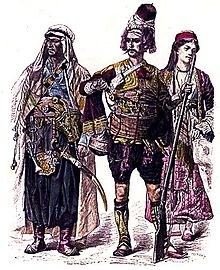Maronite Church
This is the sighted version that was marked on April 10, 2021. There is 1 pending change that needs to be sighted.
The Syriac Maronite Church of Antioch (Aramaic ܥܕܬܐ ܣܘܪܝܝܬܐ ܡܪܘܢܝܬܐ ܕܐܢܛܝܘܟܝܐ ʿīṯo suryaiṯo māronaiṯo d'anṭiokia), in short Maronites (ܡܪܘܢܝܶܐ Moronoye, Arabic موارنة, DMG Mawārina, also Maronite Catholic Church), is a Christian church united with Rome that recognizes the Roman Pontiff as its head. The Maronites are one of the largest and oldest religious communities in Lebanon; their church language is West Syriac.
The Maronites trace the foundation and name of their church back to St. Maron, a Syrian Aramaic monk. They see themselves in apostolic succession through the episcopate of Antioch.
History
Medieval
The Maronites originally spoke Syriac Aramaic and emerged in the 7th century as a breakaway from the Syriac Orthodox Church of Antioch. Their name derives from St. Maron (Arabic مارون, DMG Mārūn, Latin Maro, Syriac Maron), who lived as a monk on the lower Orontes (now Syria).
As adherents of monotheletism, they were excommunicated as heretics in 681 after the Third Council of Constantinople. Monotheletism held that Jesus Christ had a divine nature and a human nature, but only a divine will; it stood theologically between Monophysitism and the two-nature doctrine of Christ established at the Council of Chalcedon, the traditional confession of the Eastern Roman Imperial Church, as of the present-day Catholic, Orthodox, and Reformation Christian churches, and was intended to serve the reintegration of the Monophysite churches of the Armenians, Syrians, and Copts into the Imperial Church, according to the ultimately unsuccessful plans of Emperor Heracleios. Since the Maronites' rapprochement with the Roman Catholic Church in the 12th century, the Maronites have abandoned the monotheletic doctrine.
Justinian II was defeated in 694 in a battle against the Maronites, who were thus able to preserve their independence. In the following conflicts in 707 with the Islamic Caliph al-Walid I, they were driven into the mountainous regions and suffered defeat at the hands of the Abbasid occupiers in 759.
After the destruction of the monastery of St. Maroun by Syrian Muslims, they fled to Lebanon in the 10th century under the leadership of Patriarch John Maroun I, where Maronite Christianity also spread among the resident Greek, Phoenician and Arab populations. The mountains of Lebanon between Tripoli and Beirut and the villages in front of them on the Mediterranean coast still represent the only larger contiguous area in the Arab world where an almost exclusively Christian population has been able to survive.
In the 12th century, the Maronites sided with and came under the protection of the Crusaders. Their attachment in 1182 to the Roman Catholic Church also stems from this encounter. This support was punished by the Mamelukes after the departure of the Crusaders: Maronites, as well as Druze and Shiites, experienced a period of military persecution. Nevertheless, the Maronites managed to maintain and develop their links with the Catholic Church. In 1445, at the Council of Florence, they reaffirmed their affiliation and since then have been officially considered the "Eastern Church united with Rome". They are the only church of their branch that submitted as a whole to the Pope.
Druze Emirate
In the Ottoman Empire, the Maronites were able to maintain their autonomy in the remote mountainous areas, partly in cooperation with Druze feudal lords such as the Emir Fachr ad-Dīn II. Under the Emirate of the Druze 1585-1635, Druze and Maronites were able to achieve extensive autonomy for Lebanon. Lebanon in this context does not refer to the present-day state, but to the mountainous regions of the Lebanon Mountains excluding the coastal cities. Thanks to the excellent relations of the Maronites with Europe, especially with France and Italy, Lebanon experienced a cultural flowering during this period. Among other things, Maronite monks introduced the first Arabic printing presses, and Arabic was written exclusively by hand in the Islamic world until 1729. The Bosphorus viewed this culturally progressive development with suspicion, and the Ottoman backlash culminated in the execution of the emir in Constantinople. France subsequently declared in 1638 that all Catholics (and thus also the Maronites) of the Ottoman Empire were under its protection. Nevertheless, Lebanon remained under Ottoman administration until the end of the 18th century. It was only as a result of Napoleon's Egyptian campaign that the emirs of Lebanon managed to regain autonomy, which lasted until the 1840s. In the 17th century, the Shihab dynasty had inherited the emirate from the Maans; the Shihabs had come to Lebanon in the 10th century and were originally Sunni Muslims from the tribe of the Koreishites in Mecca. The Emir Bashir Shihab II, who ruled Lebanon from his magnificent residence, the Beit ed-Din Palace, in the early 19th century, had himself and his family secretly baptized Maronites, a procedure still unusual in the Orient today. The commander of the Lebanese armed forces fighting on the Allied side with de Gaulle and Eisenhower in the Mediterranean region 1942-1945 and later president Fuad Shihab descended from Emir Bashir II.
In the mid-19th century, this second Druze emirate in Lebanon declined in the wake of the conflict between Muhammad Ali in Cairo and the Ottoman leadership in Constantinople. France and Britain, trying to take advantage of the weakening of the Ottoman Empire to expand their own sphere of influence, incited Maronites and Druze in Lebanon against each other. This period is vividly portrayed in the novel The Rock of Tanios by Amin Maalouf, which won the Prix Goncourt in France.
Lebanese Independence and the First World War
Following the civil war in the Lebanon Mountains in 1860, which resulted in the deaths of a total of 20,000 Christians in Syria and Lebanon, France and Britain enforced the autonomy of the province of Lebanon Mountain, which was considerably smaller than present-day Lebanon. As a result of this move, Lebanon was administered independently by an Ottoman governor who was usually a Christian, usually a Catholic Armenian drawn from the Ottoman ruling elite in Constantinople. Lebanon's autonomy was overseen by a European commission. At the beginning of World War I, this autonomous administration was abolished and Lebanon was placed under Turkish military administration. The last Ottoman civilian governor almost became a victim of the Armenian genocide himself and escaped to Italy at the last minute. The Allied naval blockade and requisitions of food by the German and Turkish army units operating in Lebanon led to famine and epidemics, resulting in the deaths of some 100,000 of the 450,000 people then living in Lebanon, mainly Maronite Christians. During the First World War the German authorities, allied with Turkey, watched the fate of the Lebanese Christians largely inactively. Individual German politicians such as the Catholic Centre politician Matthias Erzberger were committed to the Christians in the Ottoman Empire. On the other hand there were protest actions especially in the USA, which were organized among others by Lebanese emigrants like Khalil Gibran. Many Maronites emigrated during this time, especially to the USA, Canada, Latin America, Australia and South Africa.
After the First World War, France took over the League of Nations mandate for Syria and Lebanon. The self-government of the Maronites since 1920 was then followed by their constitutionally secured role in independent Lebanon. In the National Pact of 1943, modified in 1989 by the Taif Agreement, 23 of the total of 128 seats in parliament were allocated to the Maronites; the president of the state, who, however, performs a mainly representative function, must traditionally also be a Maronite.
Development since 1970
In the Lebanese civil war, most of the Maronite family clans supported the right-wing pro-Western camp led by the Kataeb, but individual "left-wing" Maronites, especially members of the Communist Party, fought on the side of the "left-wing" camp and Fatah in the first years of the civil war. Particularly after the assassination of Kamal Jumblatt, along with Yasser Arafat the head of the "left" civil war camp in Lebanon, the "political" war increasingly turned into an "ethnic-religious" war, as a result of which also Maronite families, who until then had supported the socialist PSP of Kamal Jumblatt, were driven out of the Shuf by its predominantly Druze militias and partly fell victim to cruel massacres. As early as the late 1970s, there were bloody conflicts between rival Maronite family clans, in some of which entire families of the clan leaders (Tony Frangieh, Dany Chamoun) were brutally murdered by the "competition". Particularly in the last phase from 1985 to 1990 the civil war then increasingly turned into a conflict about the influence of Syria, in which finally after the end of the term of office of the Maronite President Amin Gemayel a final split of the Maronite camp took place, with heavy fights between the army units of the Maronite General Michel Aoun against the Maronite militia Forces Libanaises, which had emerged from the Kataeb and were led by Samir Geagea, in which thousands of civilians in the Christian areas of Lebanon fell victim. To this day, Lebanon has not sufficiently come to terms with this terrible phase of its own history, either historically or legally.

Ludovico Wolfgang Hart: Maronite from Zūq al Kabīr near Aleppo, 1865

Traditional costumes: a Maronite from Lebanon (left) next to an inhabitant of the Jebel and a Christian woman from Lebanon from the late 19th century (illustration from Zur Geschichte der Kostüme by Braun & Schneider, 1861-1880 Munich)
Church organization and patriarchate
→ Main article: "Syriac Maronite Church" in the article List of Roman Catholic dioceses.
The head of the Maronite Church, since 2011 Béchara Pierre Raï, bears the title Maronite Patriarch of Antioch and the whole Orient. His seat is in Bkerké, Lebanon.
The designation Mar means "Lord" in Syriac (cf. French Monseigneur). Throughout Syriac tradition, the designation is also given to saints. The first patriarch was John Maroun I. (687–707).
Since the Middle Ages, the Maronite patriarchs have always borne the epithet Boutros as their middle name, which translates as Peter or Peter, as a reverence to Peter, the founder of the Church of Antioch. They must be confirmed by the Pope in Rome after his election.
The title of Patriarch of Antioch is also claimed by four other churches, viz.
- Syrian Orthodox Church,
- Rum Orthodox Church in the Union of Byzantine Orthodoxy,
- Melkite Greek Catholic Church (seat Damascus) and
- Syrian Catholic Church (Beirut headquarters).
Despite their Catholic ties, the Maronites have their own hierarchy and an Eastern Church liturgy. These derive from the origin of the Maronites in the West Syrian Antiochian tradition. The liturgical language is Syriac, an Aramaic dialect. Priests may be married; celibacy is required only of priests who are still single at ordination.
The Bishop of the Maronite Diocese of Notre-Dame du Liban, based in Paris, is responsible for the Maronite Christians in Western Europe and North America. Since the foundation of the so-called eparchy in July 2012, this is Nasser Gemayel. Since 1584 there has been the Pontifical Maronite College for seminarians and priests of the Maronite Church in Rome.
.jpg)
Maronite Saint Elias Cathedral in Aleppo, Syria
Search within the encyclopedia